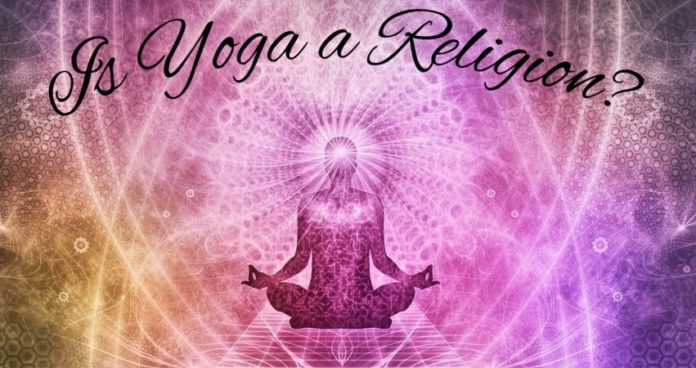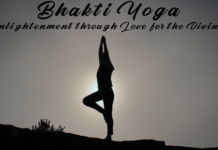Is yoga a religion or something else? Many are asking this question as yoga continues to fascinate people around the world. Yoga has undergone a fundamental change through the ages. It has become a super-culture, a brand, a fitness fad, and maybe even a modern religion.
Is Yoga a religion or an exercise?
There are many angles from which this question can be answered.
To begin, let’s go back to ancient times. The Bhagavad Gita’s definition of yoga is very interesting:
Yoga is a journey of the self, through the self, to the self.
A beginner’s guide to yoga in The New York Times defines yoga as a set of physical and mental exercises that bring yoga practitioners around the world together. It is a calming, strengthening discipline.
Matt Walsh, a religious right wing blogger for the Daily Wire called yoga a form of ‘Hindu worship’. He faced a lot of heat from the yoga community for his comments.
Shreena Gandhi, a religious studies professor at Michigan State University, wrote an academic paper accusing the Western wellness industry of cultural appropriation. Her fierce critique stated that modern yoga is a denatured form of the ancient spiritual worship practices that yoga once was.
Those are four very different answers to the same question. What kind of conclusions can we draw from them? Is yoga still a form of worship? Is it an inextricably Hindu spiritual exercise? Can it be labelled a fitness routine? These are the questions we seek answers for in this article.
The Gita’s definition of yoga clearly goes beyond the confines of a fitness program, doesn’t it? From this single quote we could conclude that yoga is a spiritual journey that involves an inner self – there is nothing there to hint that yoga is an exercise.
Wait, is this article going to go into ‘divine inner self’ meditations and such? Not exactly. But what we would want to do is to trace the evolution of yoga from a purely spiritual discipline into the modern-day spiritual commodity that it is today, complete with branding, fancy merchandise and millions of ‘spiritual’ followers. This will hopefully help us arrive at an answer to our question: Is yoga a religion?
Tracing The Evolution Of Yoga Through History
More than a religion, yoga started out as a spiritual practice. Rooted in the ancient Hindu sacred texts called the Vedas, there is a lot more to the practice of yoga than what the layman understands of it.
So, let’s go into a few basics about yoga before we attempt to answer our question. Here’s what everyone knows: yoga is a discipline that has evolved over centuries. It originated as an all-encompassing spiritual philosophy.
The first evidence of yoga can be seen in the Rig Vedas – the first of four of ancient Indian texts that are credited with the birth of yoga, as well as Hinduism. In this, and following Vedic texts, yoga was a lifestyle and a spiritual discipline. It was designed to unify the body, mind, and spirit, as well as the human with the divine (the word yoga comes from the Sanskrit word that means yoke together or bring into union). The Hindu god Shiva was credited with first performing yoga. He was the first yogi. Asanas, or body movements did not figure very prominently in his yogic discipline. It was very definitely a spiritual exercise in this context.
So it is clear that yoga can be associated with the Hindu religion. But, is it a religious practice? Is it inextricably immersed in Hinduism?
If we looked at the definition of religion, several dictionaries bring some combination of the following words together:
the consciousness of a super-human power that brought the Universe to life and set things in motion; a set of rituals or traditions designed to bring a group of people together around a set of ideas or beliefs; or the principles and rigors that bring discipline and stability into an individual’s life.
Yoga in its ancient form clearly falls within these lines. It was a discipline that was meant to raise the practitioner’s awareness of oneself, and in the process draw closer towards the divinity within oneself. This also included shedding negative influences and energies, and bringing the mind, body, and soul into harmony with one another. Ultimately the individual was striving towards rising above the physical self and to attain a higher consciousness through training and discipline.
Analyzing Modern Yoga Practices
Will you find this sort of a spiritual profile if you walked into a New York yoga studio today? I think not! In fact, yoga in the 21st century has gone through more than just a face-lift. Most yoga training centers still offer courses in a variety of yoga types, but most of these are modern birthings, mostly from the Western world. Yoga is now a set of movements and body postures that are combined with breathing exercises and meditation practices that are aimed at improving physical and mental health. This may be as a result of a greater awareness of the importance of health and mental well-being. But more often than not, this is where most people start out: a need for better physical fitness.
Where Did Modern Yoga Come From?
We have talked about the origins of yoga as a prelude to answering the question of the day: Is Yoga a religion? And it is obvious that ancient definitions no longer capture the essence of modern yoga.
Body yoga had suffered under the British colonial tag of ‘crass and vulgar’ ‘distortions’ of the body until the 19th century. It was rescued during the period of post-colonial re-awakening when there was renewed interest in developing the body and the mind. It became an enjoyable and highly effective form of exercise.
Vivekananda was the first reformer to take his ‘modern’ ideas of yoga and Hinduism to the Western world in 1893. His lectures spoke to the imagination of hundreds of thousands around the Western World. His visit marked the beginning of an exchange of ideas, philosophies and theologies between the East and the West. This was fueled by a rebellion against the Protestant Christian Church and way of life in the US and other western countries. People were opening themselves to experimenting with thought, philosophy, theology, and science. Many religions, societies and cults found their beginnings during this period. Early experimenters faced social stigma to the extent that many were imprisoned and harassed in other ways, some losing their lives in the process. This may have been the first time that yoga was examined in the light of our own question: Is yoga a religion?
This was also the time when individuals from the West embraced Hinduism and the yogic way of life. Many traveled to India, the Himalayas, and other centers of yogic life and meditative practices and brought a wealth of knowledge and wisdom home. Within the same spirit of experimentation and self-discovery, these ‘enlightened’ yogis developed newer and more stylized systems of yoga.
Examining Types Of Yoga And Their Expected Outcomes
It is now time to look closely at the newer offerings of this modern yoga world. There are hundreds of different types of yoga. Newer forms emerge continuously as styles are combined and improved upon. Some of the more basic forms of modern yoga include:
- Restorative Yoga: This type of yoga is designed to help you DE-stress and unwind after a long day’s work. Props and tools help the body ease into postures that are meant to open up channels, loosen tight muscles, and encourage breath and airflow.
- Prenatal Yoga: It combines pelvic floor exercises with breathing techniques. It even enhances bonding between mother and baby. Mothers also prepare and strengthen themselves for labor and delivery through specific asanas and breathing exercises.
- Yin Yoga: A slow, restorative form of yoga that is meant to balance the effects of the more robust forms of exertion. It enables you to slow down and become aware of your body, especially areas of pain you may need to pay attention to.
- Power Yoga: This style was developed by Beryl Bender Birch and Bryan Kest. It was launched by the book Birch released in 1995 under the same name. This practice aims to improve flexibility, and strength, and promote fluid, mindful movement.
- Bikram Yoga: If you ever consider walking into a Bikram Yoga center, make sure you carry a lot of water! These centers are artificially heated to up to 100F to encourage sweating and purging. To understand the concept, think of your body as a sponge which absorbs a lot of what goes on around it. Bikram Yoga serves as a means to wring out excess toxins from the body.
- Hot Yoga: A series of yoga exercises that may be an outcropping of Bikram Yoga. It operates by performing any of the popular forms of yoga in heated environments.
Almost all of the types of yoga mentioned above put a heavy emphasis on the body and the mind. But we could also look at many other classes of modern yoga which go deeper than mere physical fitness and mental well-being. You will hear or read many of the gurus who have developed these forms of yoga say that these are a journey towards a spiritual awakening.
Check out a few of these forms of yoga:
- White Lotus Yoga: Another modern offspring of yoga developed by Ganga White and Tracey Rich. There are various levels of White Lotus Yoga, which can be suited to the practitioner’s physical state and intentions. It focuses on posture, breath and theoretical yoga teachings.
- Jivamukti Yoga: If you’re looking for something that will test the limits of your body and combine it with some powerful meditation sequences, Jivamukti Yoga is the school for you. Developed by Sharon Gannon and David Life in 1986, this school of yoga combines Ashtanga Yoga with a series of modern and ancient spiritual teachings.
- Viniyoga: A gentle combination of practices that supports an individual through life transitions and growth into the different stages of life. It was first developed and taught by T. K. V. Desikachar.
- Svaroopa Yoga: This school of yoga was first developed by Rama Berch as a means of enabling her students to open themselves to ‘unfolding asanas’ from deep within the self, rather than forcing their bodies into uncomfortable postures.
- Kundalini Yoga: This school of yoga is an ancient secret that was brought out into the open by Yogi Bhajan in 1969. It combines postures, breathing, chanting and meditation to awaken energy from the base of the spine and raise it through the seven chakras of the body, ultimately aiming for spiritual enlightenment.
Is Yoga A Religion Or An Exercise? – Conclusions We Can Draw
So, where does this leave us in our quest?
In an interesting article titled What Yoga Is and Isn’t in the New York Times, Ganesh Das, Director and Yoga teacher at Jivamukti Yoga School in New York says that yoga is more than just a fitness regime. The original purpose of yoga is to arrive at enlightenment.
The modern yoga is merely a ‘flavor’ of the original yogic practices that sought to draw the individual away from the materialistic world and closer to the Divine.
Drawing conclusions from this article, you can’t deny that yoga is a means to a spiritual end. For a lot of people who want to rake in the extra millions, promoting yoga merely as an effective fitness program is part of daily business. It would make sense for them to strip this spiritual practice of its divinity for better marketing returns.
Could this be labelled a case of cultural appropriation? The Hindu American Foundation raised objection against this very issue a few years ago. It protested against the practice of yoga outside of its original cultural and demographic setting. While a number of people countered these statements as redundant, many started asking whether this was a valid point.
So, does it matter that yoga is practiced merely as a form of exercise? This is an important question when there are many people who have misgivings about the practice because of its Hindu background. Muslims, Christians, and Jews are wary of the wrath they might face from their own communities who label yoga ‘another religion’.
Even this problem has been solved to some extent by a number of people who have once again fashioned yoga to suit their own lifestyles. Yoga flavor has been ‘localized’ in terms of culture and belief in a number of countries and faiths. It shows just how much of an interest has been garnered towards this practice in the recent decade. Iran is a prime example. It has adopted a stripped-down version of yoga that is nothing more than a fitness program, which is quickly becoming very popular.
Because of the malleable nature of yoga, it has been molded as everything from a science, a philosophy, a lifestyle, a religion, and, of course, a fitness regimen.
Rebecca Ffrench, co-founder and philosophy tutor at Yoga London says that some types of yoga are a lot more religious than others. Hare Krishna monks are practitioners of bhakti yoga, which is undoubtedly more spiritual than the West’s popular conception of hatha yoga. It is loosely defined as the path towards enlightenment through mental and physical discipline.
It can perhaps be stated that many yoga schools teach about striving for ‘enlightenment’. But even this term can be defined in different ways based on what kind of yoga you practice. Are you striving towards breaking out of a cycle of rebirth, or realigning your understanding of the world and your place in it?
Whatever your answer to those questions, you can see how these ideas are contrary to the philosophy of many religions around the world.
I think the best we can do is to look back to ourselves to answer our question. Today’s yoga is an individualized discipline: it caters to what you want to achieve by practicing it. You have the choice to either embrace or reject it, based on your own thoughts and ideas.
For discussion on this topic you can always Discuss whether Yoga is a Religion or not in-case you see any dissatisfaction with the opinion.





[…] evokes endless love in the bhakta. Because of this non-restrictive philosophy, proponents of Bhakti Yoga state that it is not religion, caste, or gender- restricted. In fact, during times when the caste-system was a rigid social […]